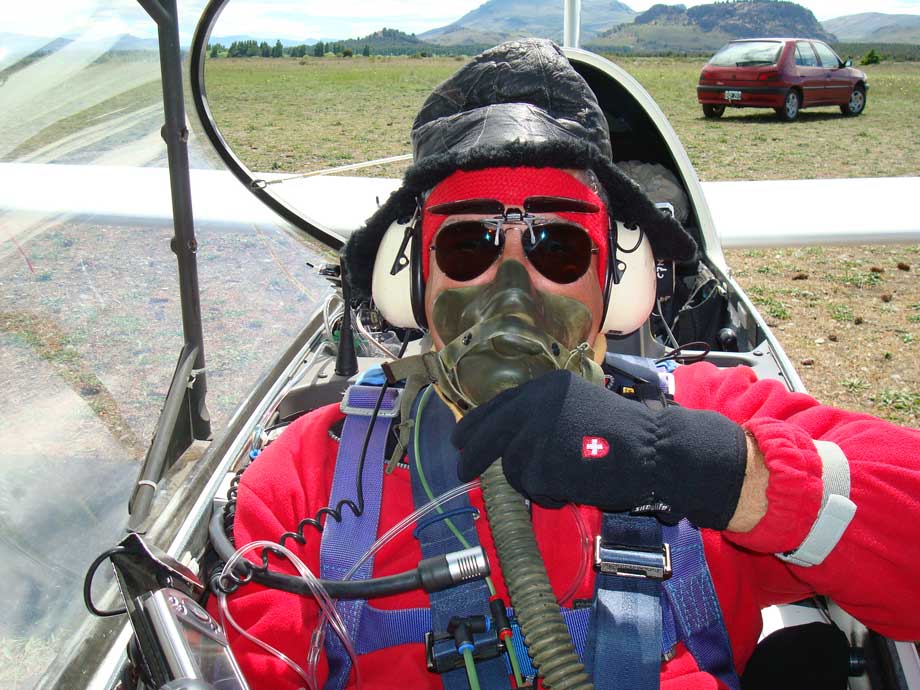This physician Swiss anaesthetist demonstrates a particular interest for the rational use of the oxygen in medical and aeronautic use. As confirmed alpine glider pilot (2.700 hours) and co-owner of an ASH-26 E well equipped, he took advantage of his stay in Patagonia to verify in a two-seater and at high altitude some hypotheses that he could not approach by one-seater in Europe. Although this domain is a lot too vast and complex to be treated in depth in this article, the topic has been treated during a previous yearly meeting of the glider pilots aero-physicians (APSV) in Saint Auban. He is also the author of an article many time cited and commented (downloadable on our www.topfly.aero website,) having like topic the systematic under evaluation of the light hypoxia (because legally tolerated) and its multiple dangers in gliding. Heini promised me that he would publish his new findings in a detailed way in a next issue of your favorite magazine.
The experimentations took place with Heini as guinea pig, equipped with his pulsoxymeter to the wrist (Minolta Pulsox 3). its very dish sensor was bandaged on the index and covered by a black glove in order to maintain a good digital microcirculation, required for a good reliability of the displayed values. Every pilot had his own ED-D1 that he adjusted in his way, but the two ED-D1S had to share the flow from only one XCR regulator by cylinder, either the one at the rear of the fuselage (8 litres @ 160 bars) either the one of the baggage compartment (4 l @ 200 bars), the two cylinder capable to be simultaneously open.

Following the disappointing previous experiences due to the waste of oxygen with various facial masks, the two pilots only used their nasal cannula, even at 8.000 m. However, Heini seized the opportunity to temporarily try his A14 mask that he modified and that he wears over the nasal cannula in order to create an enclosed humid room. Its valve being reversed so that the original entry by the pleated hose became the expiratory part in order to be able to add one to three permeable filters for air but not for the moisture. Although the first goal is the thermal conservation, this device should permit a better oxygenation by the expiratory brake that the three filters in series cause. In addition it should avoid that expired humid air reheated at body temperature can freeze on the canopy.
I therefore take advantage of these lines to transmit you our preliminary findings that you will be able to use for the flights of this summer.
- The use of the ED-D1 system in N position using the nasal cannula permits a saturation of O2 of at least 90% until 6.000 m while breathing as usual, that is to say without particular attention as for its depth.
- Although the EDS are judicious to offer sufficient oxygen at all altitudes while adapting the length of the O2 pulse automatically in the beginning of the inhalation at the static pressure, it proves to be that from 6.000 m the saturations of O2 fall below 90%, minimal value required for a good working of the central nervous system, of which the eyes, the capacity of the judgment, the perceptions etc.
- Therefore the manual increase of the length of the pulse of O2 is necessary, in return for example the positions F 10> 6.000m, F 15> 7.000 m, without hesitating to pass already on F 20 or R/M at the smallest doubt before 8.000 m. These F positions are in principle supposed to compensate for the heavy pilots, stressed, vacillating or using the “uneconomical” mask by pure obedience. Having to compensate this way the only effects of the altitude, it comes back to exhaust the safety margin in case of sharp increased needs.
- In order to keep his mental capacities, it is indispensable to maintain a rate of saturation at all times higher than 90%, better 93%. All lower value exposes to the danger that can be an erroneous, belated analysis or omitted, a bad decision, a delay in a decision in itself valid with the potential of an ulterior accident. All value lower than about 80% can bring to the immediate inability in flight. It happened to Heini, whereas he had the controls, following an unexpected attack of dry cough that didn’t want to end more. Impossible to ask “Take the controls! “, when one coughs without stop. His saturation fell down to 65%; it made acquaintance with the famous “tunnel” vision as well as with the stupor, this total inability to react, the eyes open and the ears full of reproaches coming from the backseat. Fortunately the incident occurred in laminar flight, glider well trimmed and especially in a two seater; I had well noted his absence of answer and reaction and had taken the controls therefore. On the other hand, Heini told that he had early the intention to select the R/M position in order to facilitate the recovery, but that he was already incapable to read, or even to identify whatever is on his EDS-D1, yet fixed to the belt of his shoulder to be in his visual field. His useful conscience time exhausted itself while coughing, although he had a comfortable initial saturation superior to 90% before the plunge in this experience that was subjectively less and less unpleasant, but more and more dangerous. The altitudes superior to 6.000 m very hardly forgive the temporary interruption of the oxygenation.
- All flying pilot seriously in wave (for hours above 5.000 to 6.000 m) must be equipped of a pulsoxymeter of an adeguate model and has to use it in an anticipative way. Once the identified regular digital pulse and his detection is adapted, the pulsoxymeter immediately displays usable values. But bad frequent positionings initiate every time a new research of the digital pulse, reason for which the simple and cheap pulsoxymeter of the type “digital clip” is hardly convenient in flight.
- In a two-seater glider equipped with two individual EDS, but supplied from only one XCR regulator, using the standard polyurethane tubing provided by MH (ø 2,5 mm to the departure of the cylinders and ø 4 mm toward the nasal cannula), the quantity of oxygen delivered to every pilot is equal at best to the minimum required at 6.000 m or above. It means in practice that there is the risk to be insufficient in N position when the two pilots inspire simultaneously, even though the regulator is sold to provide two times the minimal flow. It is not excluded that the ulterior division of the flow of O2 after the regulator encourages the EDS closest to the Y connector to be the most generously fed and imposes an “steal” effect to the other EDS.
- The application of the A14 mask, modified by Heini Schaffner, increases the rate of saturation of O2 by 3 to 4% in one minute, that allows for a reduction of the flow of one step for the flights at high altitude, either a saving of about 20%, which is not negligible. The optimization of the flow of O2 aims at the preservation of the reserves of oxygen on board, in order to permit two long flights while leaving with full bottles; I think here about the landings imposed by an unforeseen bad weather on a distant airfield where the return in flight the following day should use a lot of oxygen again.
- A voluntarily deepened breathing permits a better use of the pulses and increases the rate of saturation of 2% to 5% for the same flow setting. The voluntary breathing requires the pilot’s continuous attention; as soon as he is absorbed by another task in flight, he comes back to his autonomous breathing more superficial and fast, having a lower exchange efficiency and asking for an increased flow of O2.
- The delay between the variation of the flow of O2 (F10-25 positions of the EDS-D1) and the improvement of the saturation of O2 is relatively fast, but takes nevertheless a good minute. In case of under oxygenation one must not hesitate to increase the setting the selector of 2 steps for some minutes, leave to come back of 1 step a little later as soon as the improvement is displayed. The excess of consumption will be insignificant but on the other hand the result will arrive more quickly.
- The pilots suffering a deviation of the nasal baffle must imperatively modify their cannula in order to privilege the best nostril. This mechanism has been identified in practice following the complete sleeping in flight of another co-pilot! If it was about a simple nasal congestion, it would be necessary to have on board the nasal drops or spray (always present in the pocket); if the problem had to occur in flight apply the spray without removing the nasal cannula. But attention, the combination of the hypoxia, the cold weather, stress and vasoconstrictor nasal spray can increase the arterial tension whose first demonstration is sometimes an inopportune nose bleeding!
- In case of empty cylinder, icing of the regulator, electric failure of the EDS to closed solenoid valve, the emergency descent to an altitude of survival (but again not comfortable or exempt of neurological deficit), much lower than 6.000 m will take several minutes and require an emergency supply of oxygen independent from the faulty system on board. In the same way, for the flights demanding passages to high altitude (superior to 8.000 m) or for which it can be impossible to descend quickly (flights above the clouds), it is imperative to carry on board, or in the flying suit, an emergency system with changeable cartridges. A Japanese system (CO-PILO2T from MH or Oxy Mini Set by Audax-Keck) weighs 270 g and offer only about ten minutes endurance at the rate of 2 litres/min; it is delivered with 3 cartridges to 0,1 l x 180 bar = 18 litres at ground pressure.
In conclusion the question of the oxygen has a lot more important character than one uses to have, but the popularization of the digital pulsoxymeters is going to permit a better understanding and prevention of the incidents and hypoxic dangers that come with this kind of gliding flights. Gievn the limited reserves in O2 that a glider can carry on board, the EDS offers at present the best way to manage it to the pilots, but its evolution is again far from the perfection.
